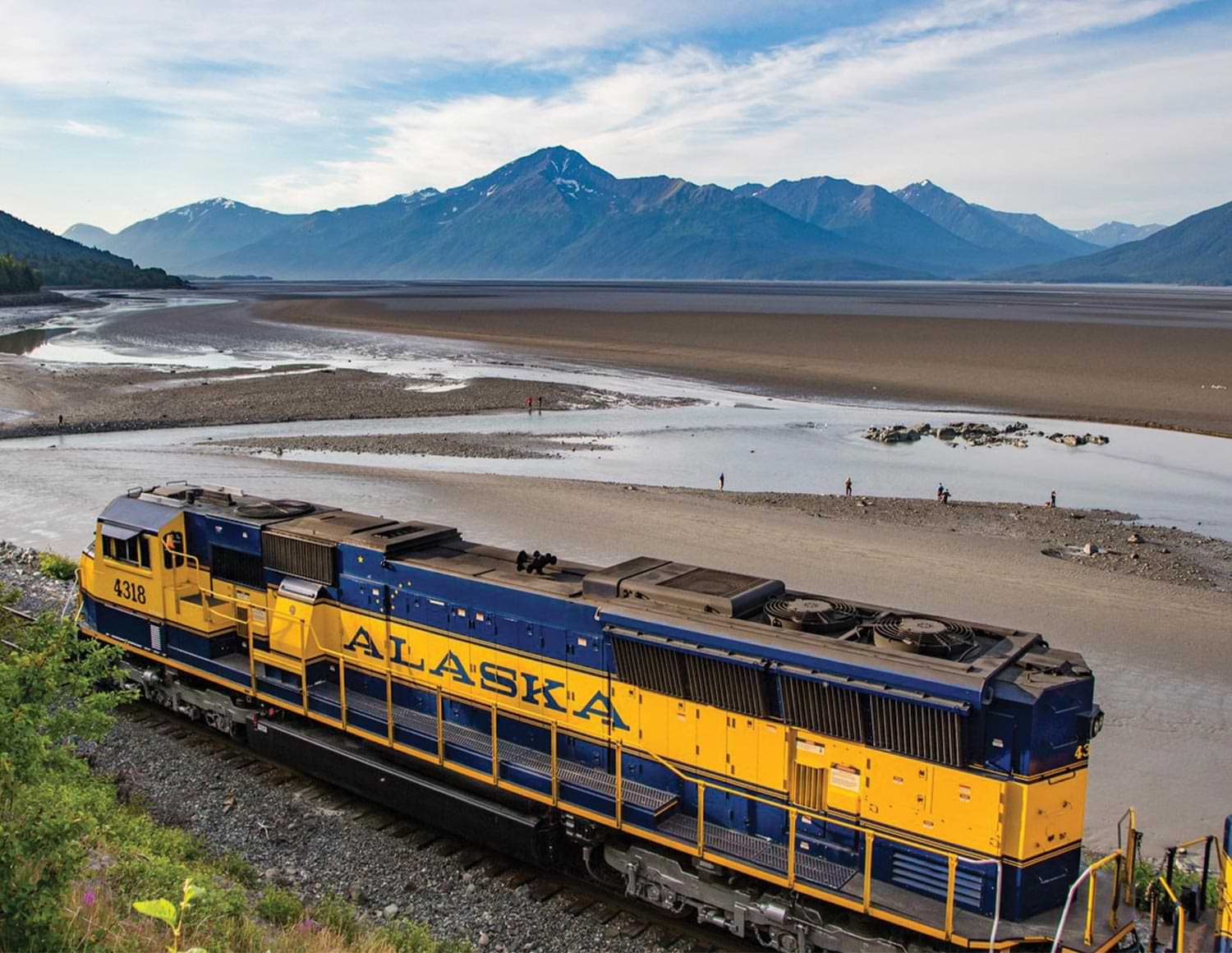
Ken Edmier | Alaska Railroad Corporation
Throttle
resumes a growth
trajectory after
pandemic disruptions
By Rachael Kvapil
oncluding its first century of existence, the Alaska Railroad Corporation (ARRC) has a lot to celebrate. After the pandemic disrupted an upward trajectory in 2019, the state-owned railroad is rebounding from a brutal downturn in 2020 and preparing for growth in the coming years. With increased revenue from freight, passenger, and real estate, ARRC is ready to undertake a significant tourism and cargo project in Seward that will have economic ripple effects to the end of its tracks.

Ken Edmier | Alaska Railroad Corporation
Full
Throttle
The Alaska Railroad
resumes a growth
trajectory after
pandemic disruptions
By Rachael Kvapil
oncluding its first century of existence, the Alaska Railroad Corporation (ARRC) has a lot to celebrate. After the pandemic disrupted an upward trajectory in 2019, the state-owned railroad is rebounding from a brutal downturn in 2020 and preparing for growth in the coming years. With increased revenue from freight, passenger, and real estate, ARRC is ready to undertake a significant tourism and cargo project in Seward that will have economic ripple effects to the end of its tracks.
The largest factor affecting this downturn in 2020 came from cruise ship cancellations during the pandemic and in 2021 the extension of the “conditional sail order” by the Centers for Disease Control and Prevention. Pre-pandemic, 47 percent of cruise ship passengers traveled aboard cruise company-owned railcars pulled by ARRC. That dropped to 17 percent in 2021 with the limited reopening of cruise ship travel. Bill O’Leary, ARRC president and CEO, says passenger travel is once again on the rise now that cruise ship travel is closer to pre-pandemic numbers.
“In 2022, we’re back to 2019 levels in terms of running a full complement of trains on the passenger side,” says O’Leary. “We’re on track to record ridership on Alaska Railroad coaches.”
Year-to-date passenger revenues (through June 2022) are $16.9 million, and they are forecast to reach $41.1 million by the end of the year. That would be nearly double the amount in 2021 and an estimated $1.5 million more than in 2019.
Though freight operations didn’t take as big a hit during the pandemic, the amount hauled during 2020 and 2021 did drop slightly, affecting overall revenues. As O’Leary explains, freight generates more than half of operating revenues (excluding capital grants). In a typical year, the railroad hauls 3 million to 4 million tons of freight. During the pandemic years, it hauled around 2.5 million tons. A lot of this had to do with the type of freight that makes up ARRC’s haul. Major lines of ARRC’s freight business include petroleum, barge/interline services, trailers/containers on flat cars, coal, gravel, and other miscellaneous in-state freight, such as specialty movements of very large or oddly shaped equipment and materials, as well as in-state shipments of cement, scrap metal, military equipment, and pipe. During the pandemic, many of the industries that relied on this type of freight faced operation disruptions and later shipping disruptions from the Lower 48.
The COVID-19 pandemic disrupted the Alaska Railroad Corporation’s growth trajectory when cruise ship operations ceased. When cruise ships returned in 2022, it was anticipated that the number of passengers riding the railroad would exceed 2019 numbers.
Alaska Railroad Corporation

Alaska Railroad Corporation
President & CEO
Alaska Railroad Corporation
“This has been a great year for freight,” says Dale Wade, ARRC vice president of marketing and customer service.
Revenues from real estate leases and permits dipped during the pandemic. In 2019, real estate brought in $22.4 million compared to $17.4 million in 2021. However, Wade explains comparing 2019 to any year following is not exactly an apples-to-apples comparison because a change to an accounting rule moved some of ARRC’s real estate revenue to “Other” revenue. Year-to-date real estate revenue (through June 2022) is $9.8 million, with forecast revenue of $21.1 million by the end of the year.
When it comes to determining the overall health of the railroad, O’Leary says comparing this year to 2021 or even 2020 isn’t as beneficial as comparing it to 2019. He says any metric will show great improvement compared to the pandemic years, so they prefer to compare this year’s increases to a year that not only finished strong but also wasn’t affected by a short-term disruption like the novel coronavirus.
Although owned by the State of Alaska, the Alaska Railroad Corporation is self-sustaining and receives no operating funds from the state. Its three major sources of revenue are from carrying freight and passengers and from real estate permits and leases.
Glenn Aronwits | Alaska Railroad Corporation
Glenn Aronwits | Alaska Railroad Corporation

Seward provides a critical connection to thousands of cruise passengers who arrive each summer and then travel throughout the state. ARRC already has interest in the dock upgrades from Royal Caribbean Group, as the two are in negotiations for a multi-year berthing agreement that features an annual revenue guarantee.
“Our cruise brands have enjoyed operating out of Seward for more than twenty years, and with this investment, our guests will continue building memories that last a lifetime,” says Wendy Lindskoog, a former ARRC executive and now Royal Caribbean Group’s regional vice president of government relations for Alaska and the West Coast. “Our aligned vision to support this new dock with the governor, legislators, and ARRC means long-term economic benefit to the region and the ability for Royal Caribbean Group to bring our newer, more energy-efficient ships to the market.”
Because ARRC has its own bonding powers, none of the project costs will be paid by state dollars. Any costs outside the $60 million in bonds will be paid through existing dock fees and capital funds. If all goes as planned, the new passenger terminal will be operational for the 2025 season. ARRC also has a project in the works to expand the freight dock. In total, the ARRC is on track to invest more than $100 million in Seward over the next five years.
Though the Seward upgrades take the spotlight, behind the scenes is the regular upkeep of railroad infrastructure. Hopp says that maintaining infrastructure is capital intensive. He expects ARRC will invest a little more than $70 million in 2022 on track and bridge rehabilitation (that is, nearly $40 million for each) in addition to improvements in equipment, business technology, and other facilities.
As for large expansion projects, Hopp says there is always talk about creating rail connections with Canada or Port Mackenzie. Though a Port Mackenzie project did make progress between 2007 and 2016, it has stalled due to a lack of funding by the Matanuska-Susitna Borough. If completed, the extension would allow for more efficient offloading of bulk resources from train to ship at the borough-owned port; shorten the distance to tidewater for Interior shippers; increase rail freight activity and development stimulated by the rail link; and benefit Railbelt communities through increased employment, contributions to the state and community tax base, and overall economic health.
As enticing as that sounds, the price tag remains an obstacle. “It is a real challenge for the state to fund a project like that,” says Hopp. “Any expansion made by the railroad will be in response to a significant need. We are not an ‘if you build it, they will come’ type of organization.”
In 2023, the Alaska Railroad Corporation will celebrate its 100th anniversary. The railroad was officially born when President Warren G. Harding drove a golden spike at Nenana in 1923.
Glenn Aronwits | Alaska Railroad Corporation
Glenn Aronwits | Alaska Railroad Corporation

“Honestly, it’s just short of a miracle that it has managed to operate for almost 100 years in some of the most inhospitable conditions, disconnected from any railroad in the Lower 48,” says O’Leary. “We may not be as large as those in the Lower 48, but we are one of a kind.”
As a self-sustaining corporation, ARRC receives no operating funds from the state. The railroad employs 600 year-round employees and 150 seasonal hires and contributes significantly to the economy by way of capital projects. O’Leary says the railroad’s five-year plan includes half a billion dollars in capital funding over the next five years. Local contractors are regularly hired for capital projects, which means money is generally spent within the state. In that vein, O’Leary sees ARRC as an economic multiplier and a key piece of infrastructure vital to development projects in Southcentral, the Interior, and beyond the Railbelt.
Though Wade didn’t provide specifics about events happening during next year’s centennial celebration, he did note that they would be “big.” Earlier this year, when ARRC sought entries for its annual commemorative artwork program, it added a request that artist submissions reflect the railroad’s centennial.
ARRC selected a winning entry in mid-April but has yet to announce the selected artist. The 2023 print will be the 44th since the program began in 1979 (a print was not done in 1984 during the ownership handover). The art print poster will be released for sale to the public by November.
“The Alaska Railroad is a symbol of economic strength and vitality,” says Wade. “We are proud of our heritage.” ![]()